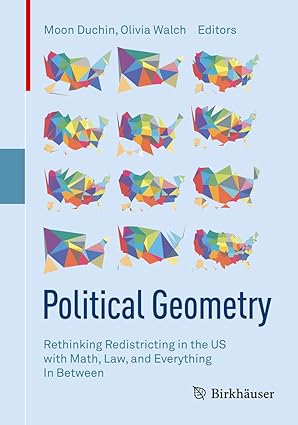
- Author: Moon Duchin and Olivia Walch, Editors
- Publisher: Birkhäuser Cham
- Publication Date: 04/02/2022
- Number of Pages: 463
- Format: Paperback
- Price: $24.99
- ISBN: 978-3-319-69160-2
- Category: gen
[Reviewed by Bill Satzer , on 01/23/2025]
The subtitle, “Rethinking Redistricting in the US with Math, Law, and Everything in Between”, describes this book pretty well. Several authors provide essays identifying the complex elements of redistricting and gerrymandering contributing to a problem that is difficult in so many ways. The book was first conceived as the proceedings of a conference of the Metric Geometry and Gerrymandering Group. The editors describe “political geometry” as a play on the phrase “political geography”, a discipline that looks at the dimensions of elections and governance. But the editors’ approach inevitably incorporates mathematics and political science as well as civil rights, history, law, and aspects of computer and data science.
Redistricting is complicated in many dimensions – including at least the social, racial, geographical, political, and mathematical. Yet – in a certain sense – the mathematical questions are easier than the others. One clear value of the book is the way it puts the question in the broad context it needs. This is not a question that has a clear mathematical solution without consideration of the many non-mathematical factors.
The book is addressed to several audiences. The broad set of potential readers include community organizers, election lawyers, and politicians, as well as mathematics, computer and data science students. This is reflected in the various sections of the book: political thought, law, geography, math and computer science, and map-making. Readers from each of these groups would probably have areas of special interest, and may well find one part or another more valuable to them.
Gerrymandering is named after Elbridge Gerry, a governor of Massachusetts who is mainly remembered for nefarious redistricting. People often identify gerrymandering as distinguished by two primary features – bizarre shapes and disproportional outcomes. But neither is reliable. In particular, strangely-shaped districts can be legitimate and can arise from physical geography- like a physical boundary - or a need to satisfy legal requirements like following county lines.
Mathematicians and mathematics students would probably be most drawn to the section that describes mathematical approaches to fair redistricting. Markov chain Monte Carlo (MCMC) methods are discussed in some detail. These are generally tuned to satisfy each state’s legal criteria while avoiding partisan biases. The goal of MCMCs in this context is to develop an ensemble of possible district maps for consideration by legislators. Such an ensemble should be broad enough to incorporate a fair representation of the variety of principles that people bring to these decisions.
This book would offer a good basis for a special course that focuses on broader mathematical and computational applications to social, political, and legal systems.
While individual sections have good sets of references, readers might find it difficult to go back to find specific information on topics of special interest to them, so any new edition of the book would benefit from an index.
Bill Satzer (bsatzer@gmail.com), now retired from 3M Company, spent most of his career as a mathematician working in industry on a variety of applications. He did his PhD work in dynamical systems and celestial mechanics.
